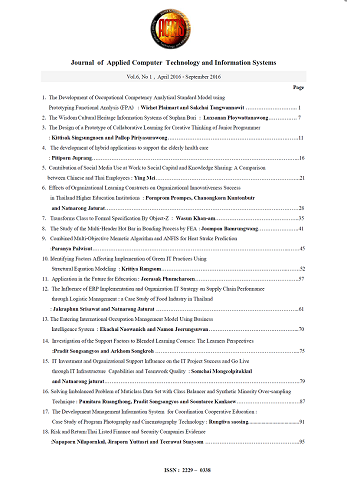Risk and Return: Thai Listed Finance and Security Companies Evidence
Main Article Content
Abstract
This research has attempted to examine the impact of risk variables on a firm’s return. The major distinction of this study with the prior research is to compare the influence explanatory risk variables, which are developed into two aspects: accounting basis; including debt ratio, debt to equity ratio and degree of financial leverage, and marketing basis; including value at risk at 95% confidence level. The dependent variables were also conducted in both aspects: accounting basis; including return on assets and return on equity, and marketing basis, including Tobin’s q ratio (market to book ratio). The research scope focused on Thai finance and security companies listed on the Stock Exchange of Thailand (SET). Data were collected in annual basis during 2010 – 2014, except daily market price for calculating market-based risk variable as value at risk at 95% confidence level. Panel data analysis was employed in term of the fixed effect models for all multiple regression models. The findings revealed that explanatory risk variables rely on both accounting basis and marketing basis played a key role to explain a firm’s return, except degree of financial leverage. Interestingly, accountingbased risk variables were negatively related to firm’s return as return on assets and return on equity, whereas marketing-based risk variables provided a negative sign only for market to book ratio. Obviously, based on adjusted R2 risk variables provided the most explanatory power on return on assets, followed by return on equity and market to book ratio respectively. This might be reflected that market-based dependent variable as market to book ratio might be impacted from internal and external risk factors. These risks might lead to financial cost and bankruptcy cost, resulting to decline in firm’s return.
งานวิจัยฉบับนี้ศึกษาผลกระทบของความเสี่ยงที่มีผลต่อผลตอบแทนของธุรกิจซึ่งความแตกต่างของงานวิจัยนี้กับงานวิจัยอื่นคือการศึกษาเปรียบเทียบระหว่างตัวแปรความเสี่ยงที่ใช้ข้อมูลทางบัญชี ซึ่งประกอบด้วย อัตราหนี้สินรวม อัตราหนี้สินต่อส่วนของผู้ถือหุ้น และ ภาระผูกพันทางการเงิน กับตัวแปรความเสี่ยงที่ใช้ข้อมูลตามกลไกตลาด ได้แก่ value at risk ณ ระดับความเชื่อมั่นที่ร้อยละ 95 นอกจากนี้ผลตอบแทนซึ่งเป็นตัวแปรตามมีการใช้ข้อมูลทางบัญชีซึ่งประกอบด้วย อัตราผลตอบแทนจากสินทรัพย์ และ อัตราผลตอบแทนจากส่วนของผู้ถือหุ้น และการใช้ข้อมูลตามกลไกตลาด ได้แก่อัตราส่วน Tobin’s q (อัตราส่วนราคาตลาดของสินทรัพย์ต่อมูลค่าตามบัญชีของสินทรัพย์) ขอบเขตงานวิจัยนี้ศึกษาเฉพาะกลุ่มบริษัทเงินทุนและหลักทรัพย์ที่จดทะเบียนในตลาดหลักทรัพย์แห่งประเทศไทย โดยใช้ข้อมูลรายปีระหว่างปี 2553 – 2557 ยกเว้นข้อมูลราคาตลาดของหุ้นที่ใช้ข้อมูลรายวันเพื่อคำนวณ value at risk การวิเคราะห์ข้อมูลเป็นแบบ Panel data โดยใช้สมการถดถอยพหุคูณแบบ fixed effect models ผลการวิจัยพบว่า ตัวแปรความเสี่ยงที่ใช้ข้อมูลทางบัญชีและข้อมูลตามกลไกตลาดเป็นปัจจัยสำคัญที่สามารถอธิบายผลตอบแทนของธุรกิจ ยกเว้นตัวแปรภาระผูกพันทางการเงิน ตัวแปรความเสี่ยงที่ใช้ข้อมูลทางบัญชีมีความสัมพันธ์เชิงลบกับอัตราผลตอบแทนต่อสินทรัพย์ และอัตราผลตอบแทนต่อส่วนของผู้ถือหุ้น ขณะที่ตัวแปรความเสี่ยงที่ใช้ข้อมูลตามกลไกตลาดก็มีความสัมพันธ์เชิงลบต่ออัตราราคาตลาดของสินทรัพย์ต่อมูลค่าตามบัญชีของสินทรัพย์เช่นกันเป็นที่น่าสังเกตว่าเมื่อพิจารณาจากค่า adjusted R2 พบว่ากลุ่มตัวแปรความเสี่ยงมีความสามารถในการอธิบายผลตอบแทนของธุรกิจในรูปของอัตราผลตอบแทนต่อสินทรัพย์ได้มากที่สุด ตามด้วยอัตราผลตอบแทนต่อส่วนของผู้ถือหุ้น และ อัตราส่วนราคาตลาดของสินทรัพย์ต่อมูลค่าตามบัญชีของสินทรัพย์ ตามลำดับ ซึ่งผลที่ได้สะท้อนให้เห็นว่าผลตอบแทนที่ใช้ข้อมูลตามกลไกตลาดน่าจะได้รับผลกระทบจากปัจจัยความเสี่ยงทั้งภายในและภายนอกธุรกิจซึ่งความเสี่ยงเหล่านี้จะนำไปสู่ต้นทุนทางการเงินและต้นทุนการล้มละลายซึ่งย่อมส่งผลต่อการลดลงของผลตอบแทนของธุรกิจ
Article Details
It is the policy of ACTISNU to own the copyright to the published contributions on behalf of the interests of ACTISNU, its authors, and their employers, and to facilitate the appropriate reuse of this material by others. To comply with the Copyright Law, authors are required to sign an ACTISNU copyright transfer form before publication. This form, a copy of which appears in this journal (or website), returns to authors and their employers full rights to reuse their material for their own purposes.

